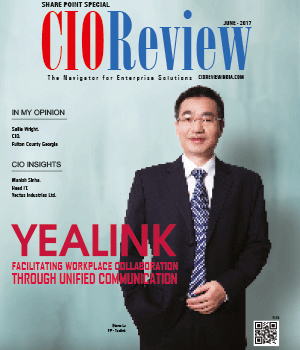
Information Technology and its Current Trends
Ravindra Deshpande, Head IT, Universal Sompo General Insurance Co. Ltd
 21st century has been defined by application and advancement in Information Technology where Information technology has become an integral part of everyone’s daily life. IT has served as a big change agent in different aspects of businesses and society. It has also proven as game changer in resolving economic and social issues.
21st century has been defined by application and advancement in Information Technology where Information technology has become an integral part of everyone’s daily life. IT has served as a big change agent in different aspects of businesses and society. It has also proven as game changer in resolving economic and social issues.
Advancement and application of Information Technology are ever changing and hence some of the latest trends in IT could be listed as follows:
1. Cloud Computing
One of the most talked about concepts in Information Technology is Cloud Computing. Cloud computing is defined as utilization of Computing Services, i.e. Software as well as Hardware as a Service over a Network, typically the Internet.
Some of the benefits of cloud computing are as follows:
• Cloud computing reduces IT infrastructure cost of the company.
• Cloud computing promotes the concept of Virtualization, which enables Servers and Storage Devices to be utilized across organization.
• Cloud computing makes maintenance of software and hardware easier as installation is not required on every end-user’s computers.
2. Mobile Application
Another emerging trend within Information Technology is Mobile Applications (software application on Smart phone, tablet, etc). Mobile applications or Mobile Apps have become a success since its introduction. These apps are designed to run various business applications on Smartphones, Tablets and other mobile devices.
3. User Interfaces
User interface has undergone a revolution since introduction of Touch-Screen devices. The Touch-Screen capability has revolutionized where end-users interact via Applications. Touch-screen enables the user to directly interact with what is displayed and also removes any intermediate hand-held device like the mouse.
4. Data Analytics
The field of Analytics has shown considerable growth in the field of Data Analytics, Predictive Analytics and Social Analytics.
Data Analytics is a tool used to support decision-making process. It converts raw data into meaningful information to be used in MIS reports.
Predictive Analytics is tool used to predict future events based on current and historical information present.
Social Media Analytics is a tool used by organizations to understand and accommodate social customer needs.
It’s astounding to have the power to retrieve almost any information and communicate in thousand different ways using a device in form of BI – MIS (Business Intelligence and Management Information System).
I would add following trends as well to the list of major tech trends for in 2017.
a. IoT(Internet of Things) and Smart Home Tech:
The "Internet of things" (IoT) is a giant network of connected "things" and a connecting relationship between people-people, people-things, and things-things which realizes virtually endless opportunities and connections.
b. Augmented Reality and
Virtual Reality:
Virtual reality (VR) is an artificial, computer-generated simulation or recreation of a real life environment or situation. It immerses the user by making them feel like they are experiencing the simulated reality first-hand, primarily by stimulating their vision and hearing.
Augmented reality (AR) is fast-coming into the mainstream. It is used to display score overlays on telecast sports games and pop-out 3D emails, photos or text messages on mobile devices.
c. Automation:
IT automation is a large category, and can cover anything from the simple automatic routing of forms or PDF files and other relevant data to intended recipients, to something more complex such as the automated processing of applications, visioning of backup and recovery of systems.
d. Big Data:
Big data is a term that describes the large volume of data – both structured and unstructured data.
Big data has also been defined by the four Vs:
• Volume. The amount of data, while Volume indicates more data, it is the granular nature of the data that is unique.
• Velocity. The fast rate at which data is received and perhaps acted upon. The highest velocity data normally streams directly into memory versus being written to disk.
• Variety. New unstructured data types. Unstructured and semi-structured data types, such as text, audio, and video require additional processing to both derive meaning and the supporting metadata.
• Value. Data has intrinsic value. There are a range of quantitative and investigative techniques to derive value from data. The technological breakthrough is that the cost of data storage and compute has exponentially decreased, thus providing an abundance of data from which statistical analysis on the entire data set versus previously only sample.
e. Everything On-Demand:
People are getting used to have everything on demand via phone-apps. We have thousands of mobile apps and apps otherwise available to let us get whatever is required or prevailing trends of utilizing facilities with respect to everyday activities we’ll see this evolve into even stranger territories.
CIO Viewpoint
Gen AI: Transforming Cloud Solutions for...
By Matt Yanchyshyn, VP - AWS Marketplace & Partner Services, AWS
Upcoming Technological Advancements in Payments...
By Pinak Chakraborty, CIO of Airtel Payments Bank
Shaping the Future of AI: Talent, Innovation,...
By Yann LeCun, Chief AI Scientist at Meta
CXO Insights
How the Enterprise Division is Contributing to...
By Vijay Wadhawan, Associate Director, Panasonic India
Leverage SharePoint to Foster the Culture of...
By Dave Long, Director in the Velocity Solutions Practice, Tribridge
Dealing with the Adoption Challenges of...







